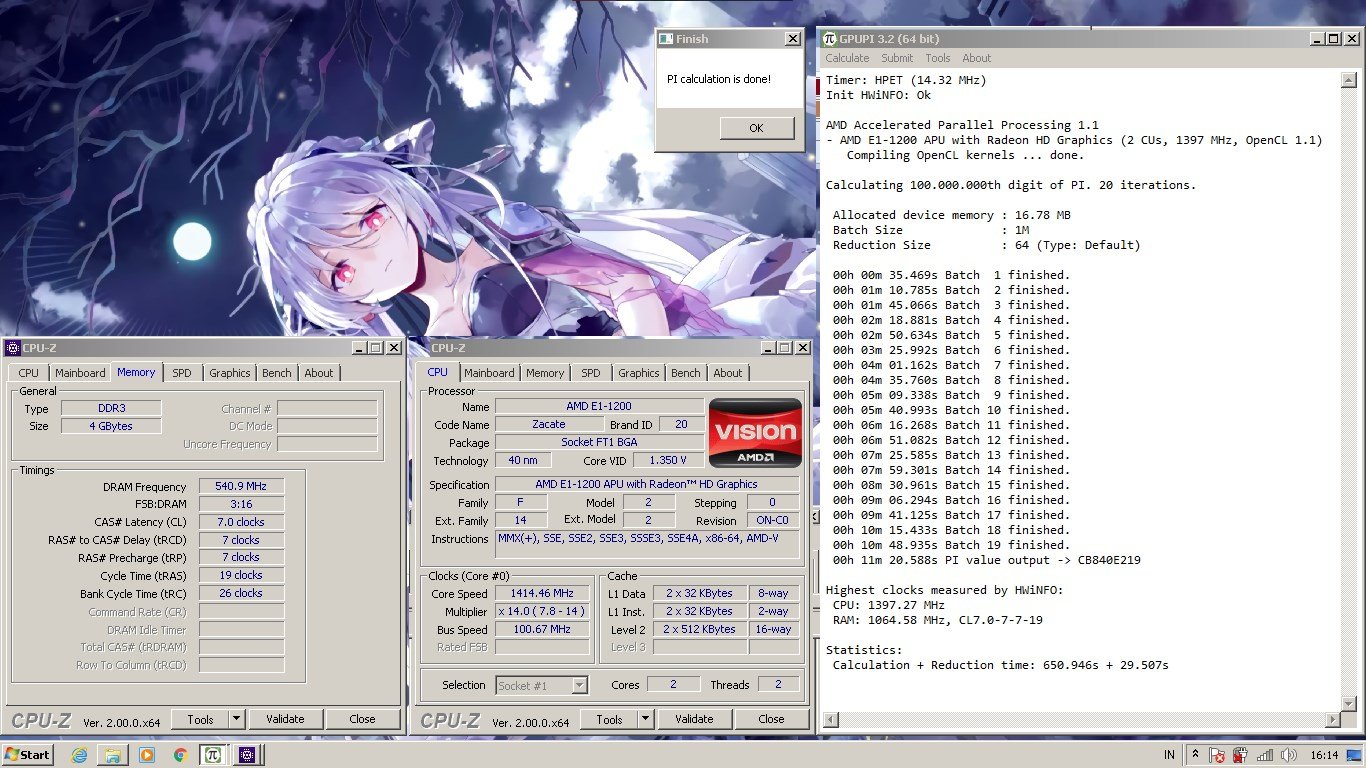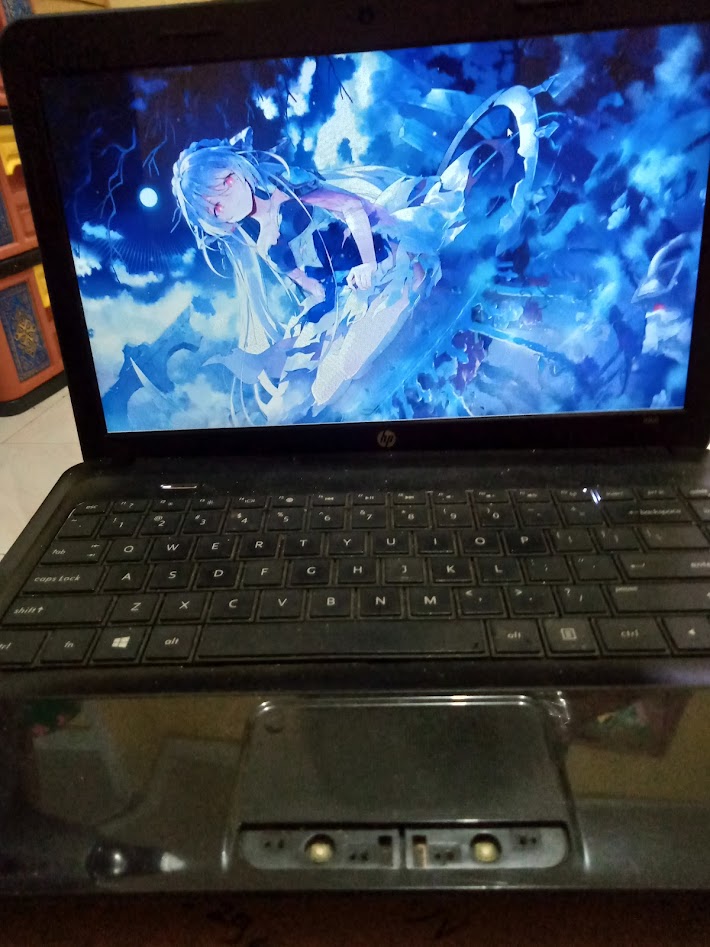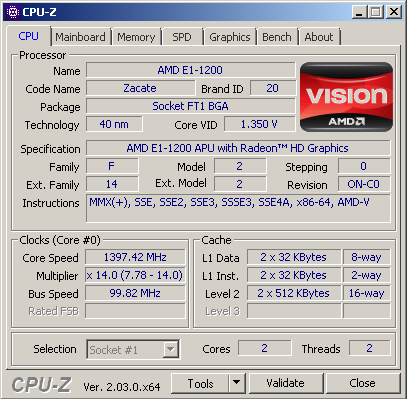GPUPI for CPU - 100M score 11min 20sec 588ms with a E1-1200
Thursday, 01 January 1970 07:00 | Update at null
Media Gallery
Screenshot

Device, Setup, etc



URL
https://hwbot.org/submission/4954146https://www.facebook.com/hakimnu.id/posts/3243092849256689
Information Detail
Hardware: AMD E1-1200
Specs:CPUID : AMD E1-1200 APU with Radeon(TM) HD Graphics
Architecture : x86
Codename : Zacate
L3 Cache : -
Clock : 1.4GHz
Core/Thread : 2/2
TDP : 18W
Technology : 40nm
Socket : FT1 BGA 413-Ball
IGPU : AMD Radeon HD 7310
See more specification...
Software: GPUPI for CPU - 100M
Score: 11min 20sec 588ms
About: GPUPI for CPU - 100MGPUPI for CPU – 100M is a benchmark designed to measure the performance of a processor (CPU) in performing intensive mathematical calculations, specifically in calculating the value of π (pi) to 100 million decimal places. This benchmark uses the BBP (Bailey–Borwein–Plouffe) algorithm, which has been optimized for high performance on modern systems, and supports various CPU architectures and instructions.
Although GPUPI was originally developed for GPUs, the “for CPU” version enables testing of numerical processing performance using the full CPU core. This test is highly demanding and is often used to evaluate system stability, single-core performance, and multi-core performance of a CPU. In the 100M configuration, this benchmark provides a moderate-to-heavy workload that adequately represents system performance in scientific calculation scenarios, data analysis, and encoding tasks.
This benchmark automatically detects and utilizes all available threads in the system to accelerate the computation process, but it can also be run in a limited thread mode for more specific testing. The final score is displayed in units of time (seconds), where a lower number indicates better performance.
GPUPI for CPU – 100M is also a popular choice in the overclocking community due to its consistency in delivering precise results and its sensitivity to changes in frequency and system stability. With its heavy and stable workload, this benchmark can also be used for stress testing and system validation in extreme configurations.
Additionally, GPUPI supports integration with BenchMate, which provides score verification and protection against benchmark result manipulation, making it a reliable tool for competitions and professional hardware evaluations.
Overall, GPUPI for CPU – 100M is an ideal benchmark for measuring a processor's arithmetic capabilities under real-world conditions, particularly in tasks that heavily rely on numerical performance and system stability.
Released in 2012 as part of the Brazos 2.0 family, the AMD E1-1200 is a power-efficient processor aimed at entry-level laptops. It has a 2 core and 2 thread configuration with a fixed clock speed of 1.4 GHz, with no support for Turbo Core technology. Built with a 40nm fabrication process, the E1-1200 has a TDP value of 18 watts-efficient enough for portable devices that emphasize low power consumption and longer battery life. Despite its limited performance, the E1-1200 was a popular choice in its day thanks to its affordable price and ability to handle light computing needs.
One of the main advantages of the AMD E1-1200 is the integrated Radeon HD 7310 GPU, which offers better graphics performance than Intel's entry-level graphics solutions at the time. This GPU has the ability to play HD resolution videos smoothly, as well as run light games such as Counter Strike 1.6, Plants vs Zombies, or other casual games with minimum graphics settings. That said, this combination of CPU and GPU is not intended for heavy-duty work such as video editing, 3D rendering, or modern gaming. Overall performance is more optimal when used for tasks such as browsing, streaming videos, accessing social media, typing documents, as well as basic office applications.
However, it should be noted that the AMD E1-1200 is less suitable for heavy multitasking, especially in modern operating systems like Windows 10. With a low clock speed and no Boost feature, users may experience lag or limitations when opening multiple applications at once. In tests using the HP 1000 1b05au laptop, this processor was paired with 4GB DDR3 single channel RAM (2 DIMM slots) and tested on Windows 7, Windows 8, and Windows 10 operating systems. The results show that the most optimal performance is achieved on Windows 7 or Windows 8, while in Windows 10 the system tends to be slow although it can still be used for basic needs. As such, the AMD E1-1200 can still be relied upon as a power-efficient and inexpensive solution for users with very light computing needs.
Hardware Detail:
Device: HP 1000 1b05au
RAM: 4GB DDR3 Single Channel 2 DIMM
OS: Windows 7, Windows 8, Windows 10
* Not Avaiable
